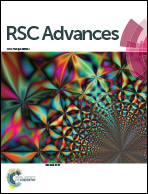Evolution of excitation wavelength dependent photoluminescence in nano-CeO2 dispersed ferroelectric liquid crystals
Abstract
The optical properties of nano-ceria (nano-CeO2) dispersed ferroelectric liquid crystals (FLCs) have been investigated by excitation wavelength dependent photoluminescence (PL) spectroscopy. The PL spectra of nano-ceria exhibited a strong excitation wavelength dependence in the 255–370 nm range. The red shift in the violet emission band of ceria i.e. from 368 nm to 396 nm with increasing excitation wavelength, has been attributed to the recombination of electrons trapped in the defect band and the deeply trapped holes in oxygen vacancies. This excitation wavelength dependence of ceria has noticeably been manifested in the PL response of FLC–CeO2 nanocomposites as well. PL emission recorded at an excitation wavelength where host and guest materials show intense emission, i.e. 340 nm, exhibits a quenching effect connected to the overlapping of emission and absorption bands of the host FLC and guest ceria NPs respectively. No blue/red shift in the spectral energy band was observed at 310 and 340 nm excitations. On the other hand, emission spectra at a lower excitation wavelength followed a reverse trend: an increase in the emission intensity, with a large blue shift in spectral energy band. The mechanisms involved in the changes of the PL spectrum of FLC–ceria nanocomposites with varying ceria concentration and excitation wavelengths are discussed in detail.


 Please wait while we load your content...
Please wait while we load your content...